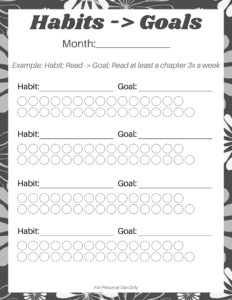This Year: Turn the Habits You Want into Manageable Goals!
3…2…1…Happy New Year!
The start of a new year means new resolutions, manifestations, goals, and aspirations. And what better way to track those resolutions than through a habit tracker, right? Habits trackers provide many benefits, most notably providing a bold, organized way to view how often you engage in a positive behavior. Plus, it looks super cute when those bubbles fill up with vibrant colors.
Yet, does this situation sound familiar? Imagine you are filling in your habit tracker, you have fourteen perfectly filled out bubbles in rich shades of blue, green, and orange, when suddenly, on the fifteenth day you aren’t able to fulfill the habit. Now you have an empty bubble, sitting there, looming among the field of color, like an eyesore. You could start to think, “Maybe I should just re-start the habit tracker next month when I can have a fully coloured page again.”
Dawn of the “Streak Syndrome”
I personally call this experience the “streak syndrome,” although that’s not actually a clinical term. For me “streak syndrome” is similar to that feeling of obligation to return to something on a daily basis, such as a game or a social media app, getting a rush as your daily streak score goes up, and then feeling a sense of being disheartened when all of your hard work returns to zero because you needed a day off.
This sense of feeling obligated to complete a task or else it is a failure is known as all-or-nothing thinking. All-or-nothing thinking is a type of thought trap, or unhelpful way of looking at a situation that seems to automatically come to mind. Another thought trap that may come from habit tracking is called personalization where thoughts like “I failed” or “I am no good at this” may occur on days the bubble cannot be filled in.
The Art of Healthy Habit Tracking
The good news is, there is a way to habit track where you can get the benefits of an organized, visual way to track your progress, without running as high of a risk of falling into thought traps.
By turning habits into realistic goals, you can get the benefits of having a wonderful, visual to stay on track, but with less guilt on the days you may need a break. There are three main ways to turn habits into more manageable goals, which I discuss below. To provide an example, let’s say I originally want to set the habit of reading 50 pages daily, but I have a really packed schedule, and I am more interested in listening to audiobooks than reading them. Here is how you would utilize the three steps:
1) Turn large habits into smaller, more manageable goals.
Want to complete a project? Want to engage in an activity like exercising, but it is new for you? Want to meditate, but your schedule is busy? Make sure your goal is realistic to the amount of time that is in your schedule, as well as, to the level of endurance you have currently. For example, if you want to start High Intensity Interval Training (HIIT), but you do not normally exercise, you may want to start with yoga or pilates to build up your endurance first. Or start with just a few minutes of HIIT. Using my example above for wanting to read 50 pages in one sitting as an ultimate habit, you could start out with a goal of reading a chapter in one sitting rather than 50-pages all at once.
2) Make the frequency of the habit rest-day friendly
Something I love to ask my clients is this: “If you needed a day off from work or school would you be angry with yourself for that?” I am almost always met with “no of course not!” The same goes with our habits. Take exercise for example, most professionals would encourage you to have a rest day after multiple days of consistent working out, in order for your body to recharge again. The same can apply for other positive habits, like cooking a healthy meal (it’s okay to want to eat out too!) or going outside (trust me, very few people want to go out in bad rain and snow). Using my previous example of reading with a busy schedule, perhaps my goal will be to read three times a week, instead of every day.
3) REWARD YOURSELF AND GIVE CREDIT
I put this last one in all capitals because of how important it is. Making sure you give yourself credit is essential for making goals and habits stick. Whether that’s acknowledging “good job” or “I am proud of myself” each (that’s right, each) time you fill in a bubble, or engaging in some self care at the end of the week or month for meeting the quota you made in step 2. It is important to celebrate the wins – no matter how big or small. Using the reading example, I might set a reward of giving myself a verbal affirmation each time I read a new chapter or enjoying a snack I love after meeting my 3x per week goal. Just as importantly, giving yourself positive self-talk when it simply is not feasible to meet your goal is part of the process too. For example you can say, “I wasn’t expecting a new assignment at work, there was no way I would have had time to complete my habit goal this week” or “I wasn’t feeling well, I needed to prioritize getting better first.” Give yourself permission to celebrate the successes and the self-compassion when it isn’t possible.
Putting it all-together, healthy habit tracking should consist of three parts: a realistic intensity to the habit, a goal of how often you would like to do it (that allows for rest days!), and providing yourself with credit and rewards. Hopefully this allows for a much more fluid and less stressful process with reaching your goals!
Your Very Own Habit Tracker
To help put this concept into practice I have included a FREE habit tracker for personal use using the framework in this article. With this tracker, I have included space for you to track up to four goals in a given month.
The tracker includes writing an original general habit (i.e. exercise, cooking, journaling, meditating, etc.) and then a space for you to turn that habit into a goal using the above structure of making it smaller and utilizing a feasible frequency. For each habit I have included 31 bubbles to be filled out, representing each day of the month so you have enough space no matter which month it is. You will see on this handout I did not include a space for a reward, and that was purposeful. Rewards shouldn’t be stagnant, and you will want to mix up what that reward is frequently or else the reward may feel more routine and less special. Additionally, if you are keeping track of giving yourself credit or the reward, then that portion of this exercise may start to feel like another habit to keep track of, instead of being the personalized, special experience it is intended to be.
Next Steps
Enjoyed this strategy? Want to learn more about some of the things mentioned in this article, such as thought traps? At online-therapy.com we offer an entire section of our program dedicated to thought traps as well as other aspects of Cognitive Behavior Therapy. To help keep you accountable in your goals, you can also work one-on-one with a licensed counselor each step of the way.
To learn more please visit https://www.online-therapy.com/
Happy goal tracking!
References:
Online-therapy.com, . (2020, June 6). Section 5: Problematic Thoughts. Online Therapy That Works – Start Getting Happier Now! Retrieved from https://www.online-therapy.com/sessions.php?order=98268&id=1685343&pID=139 Subsection: Worksheets: My Thought Traps





Leave A Comment